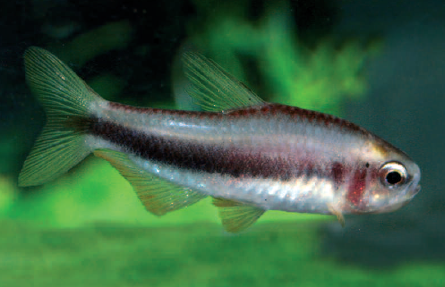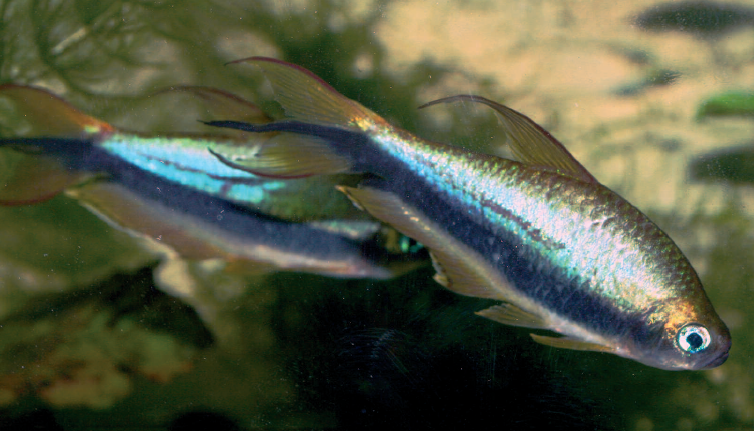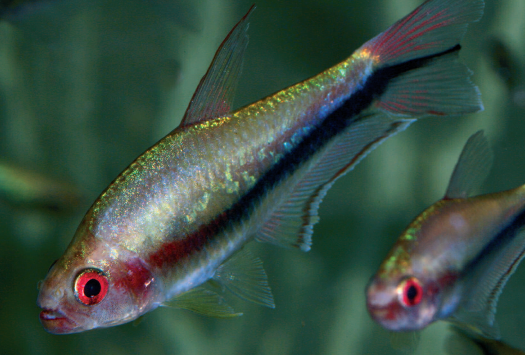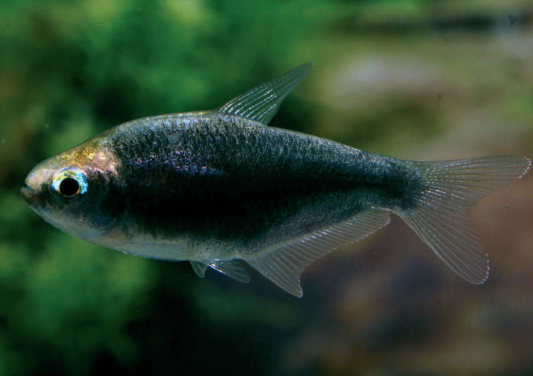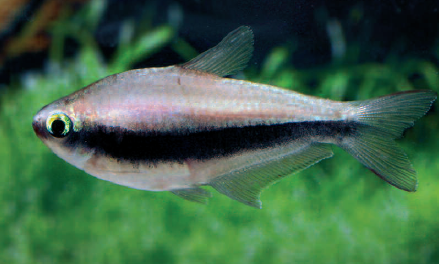
In 1958 William A. KYBURZ, an ornamental fish exporter based in Bitaco, Colombia, discovered a gorgeous tetra, never before seen alive. The species was subsequently identified as Nematobrycon palmeri (EIGENMANN, 1911). KYBURZ exported the species to the United States in 1960 and portrayed it for the first time in the magazine ”The Aquarium”. He gave it the name Emperor Tetra. And thus began the victorious progress of this fish all over the world…
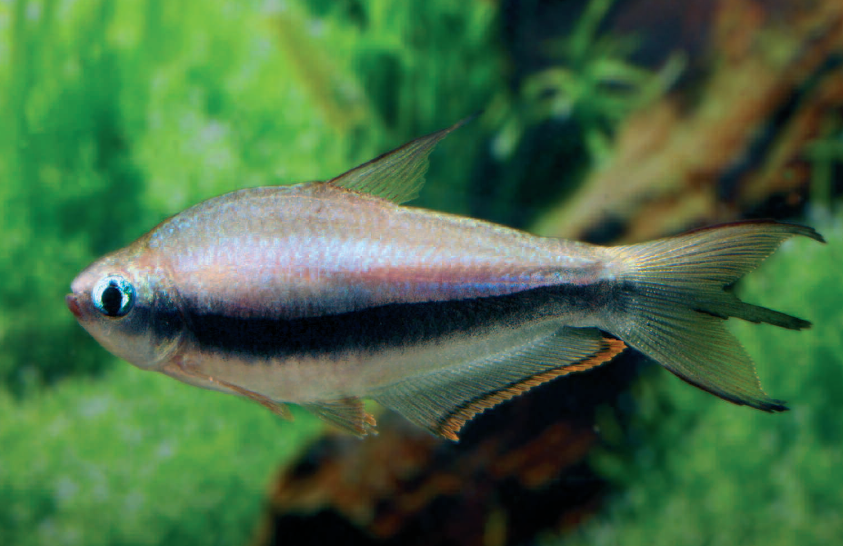
55 years of captive breeding have had little effect on the Emperor Tetra – they still look just like wild-caught specimens.
KYBURZ collected the first Emperor Tetras in the late 1950s and early 1960s in the Choco region of Colombia. Unfortunately we don’t know exactly where he made his collections, as when scientists Stanley H. WEITZMAN and William L. FINK were scientifically describing another species of emperor tetra in 1970 and tried to obtain this information, Kyburz was already dead. But note that his name will live on for as long as humans exist, as a further species of tetra, and one relatively closely related to the Emperor Tetra, was named Pseudochalceus kyburzi (SCHULTZ, 1966) in his honor.
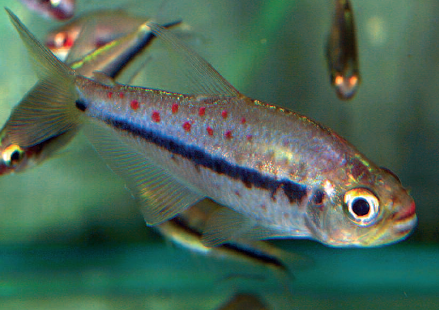
Pseudochalceus kyburzi was named in honor of the discoverer of the Emperor Tetra. The species is a particular rarity in the aquarium.
Ideal aquarium fishes
So what actually makes for an ideal aquarium fish? It must look attractive, be peaceful, remain small, be easy to feed, not eat aquatic plants, and be easy to maintain. All attributes that can be applied unreservedly to the Emperor Tetra, which grows to only four to five centimeters long. And because breeding the Emperor Tetra doesn’t present any major problems either, the worldwide requirement for the species can be easily satisfied whenever necessary.
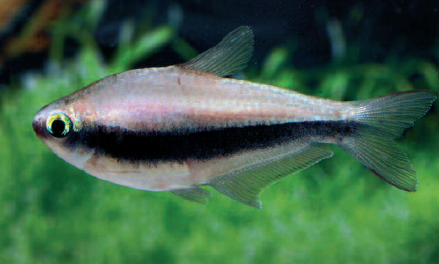
The females of Nematobrycon species (here N. palmeri) can always be easily recognized, as they lack the prolongation of the central caudal-fin rays.
How many species?
The genus Nematobrycon was erected in 1911 by Carl H. EIGENMANN. The type species is Nematobrycon palmeri, which EIGENMANN described immediately following the description of the genus, in the same paper. EIGENMANN defined the genus on the basis of the unique combination within the characin family (Characidae) of a three-pointed caudal fin and the absence of the adipose fin normally so typical of characins. The type specimens of N. palmeri were 8-20 mm long, and collected by Mr. M. G. PALMER (a wildlife collector who also collected reptiles and amphibians for the British Museum) near Condoto on the Rio Condoto and Novita on the Rio Tamana, both in south-west Colombia. Just three years later EIGENMANN and his colleague Charles WILSON described the species Nematobrycon amphiloxus. This species was said to be very similar to N. palmeri, but more robust in build. In addition they distinguished it by the dark longitudinal band not being bounded dorsally by a sharply defined, light longitudinal band, but instead rather diffuse. The original description was based on 79 specimens measuring between 14 and 54 mm in length. The type locality is Boca de Raspadura, with one specimen apiece from Tambo, Manigru, and Istmina. When another Nematobrycon species was exported alive by KYBURZ in 1961, he assumed that it was none other than this N. amphiloxus. The second species of emperor tetra exported alive has brilliant red eyes in life, and this is the best way of distinguishing it from the blue-eyed N. palmeri. Until the beginning of the 1970s this gorgeous emperor tetra, also known as the Rainbow Tetra, was widely available in the hobby as N. amphiloxus.
- This as yet scientifically undetermined fish from Brazil (imported by Aquarium Glaser in 2009) is undoubtedly very closely related to the emperor tetras.
- Emperor Tetra, Nematobrycon palmeri.
Only then did the two scientists mentioned earlier, WEITZMAN and FINK, examine the matter more closely. Their detailed detective work revealed that the red-eyed Rainbow Tetra was in reality a species new to science, which they named Nematobrycon lacortei in honor of ornamental-fish breeder Rosario La CORTE of Elizabeth, New Jersey. Because the type specimens were captive bred and the original collector (KYBURZ, in 1970) was no longer alive, WEITZMAN and FINK were able to specify the type locality only on the basis of indications (personal correspondence from KYBURZ to La CORTE and Leonard P. SCHULTZ). It probably lay in the upper course of the Rio Calima.So where did that leave Nematobrycon amphiloxus? Well, a number of very dark specimens had unexpectedly turned up among the offspring of the first wild-caught stocks of N. palmeri. La CORTE deliberately bred this strain further. It still exists today under the name Nematobrycon palmeri “Black”, though the current strains are even darker than the original specimens – the result of the continuing efforts of breeders. WEITZMAN and FINKwere able to demonstrate that it was precisely such dark-colored specimens on which the description of Nematobrycon amphiloxus was based. Hence Nematobrycon amphiloxus is now regarded as no more than a synonym of N. palmeri.
- The Rainbow Tetra, Nematobrycon lacortei, is best distinguished from N. palmeri by its red eyes.
- Female of the black form of the Emperor Tetra.
Geographical isolation
It cannot be ruled out that the Emperor Tetra is currently undergoing a speciation phase and that the dark amphiloxus is already in the process of becoming a distinct species. All emperor tetras live in small forest pools that are linked to the upper reaches of the rivers of the Colombian Choco region only during periods of inundation. In the case of N. palmeri it is the drainage of the Rio San Juan and Rio Atrato, and in the case of N. lacortei the Rio Calima. The San Juan and the Calima do indeed unite eventually, but the main rivers are insuperable barriers to the inhabitants of forest pools. They cannot come into contact with one another. It is likely that the populations of the typical N. palmeri and the dark N. amphiloxus were also originally separated in this way. But within historic times the Spanish colonial rulers dug a canal between the Rio Atrato and the Rio San Juan. One can well imagine that such a canal, containing still, almost stagnant water, would not represent a serious barrier to a species such as the Emperor Tetra. And thus the originally isolated populations of the Atrato and the San Juan probably became mixed together again through the influence of Man. It can be regarded as certain that the emperor tetra species scientifically described to date are closely related to one another. There are no barriers to hybridization between N. palmeri and N. lacortei in the aquarium. Anyone lucky enough to obtain wild-caught stocks should always breed the strains true to type. It is very probable that there are as yet unknown Nematobrycon populations in the drainages of the numerous rivers of south-western Colombia.
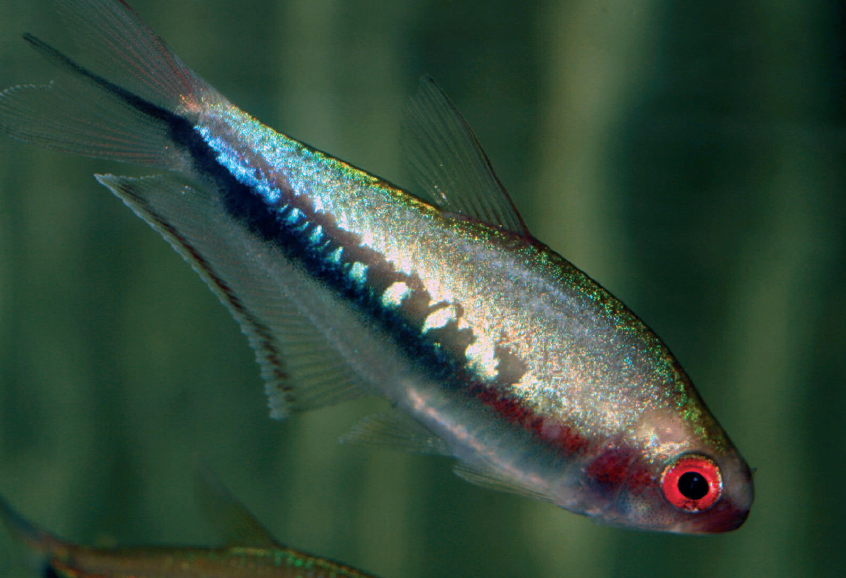
Nematobrycon lacortei male.
Surprise!
But there is also at least one species of characin found outside Colombia that can perhaps be assigned to the emperor tetra group. This species, which is as yet undescribed scientifically, originates from Brazil (unfortunately no more precise details are available). The adipose fin is absent, as in Nematobrycon, but the central prolongation of the caudal fin is also lacking. The caudal fin is more like that of Inpaichthys, the Royal Tetra, which can be distinguished from Nematobrycon by two characters: a caudal fin lacking any central prolongation and the possession of an adipose fin.
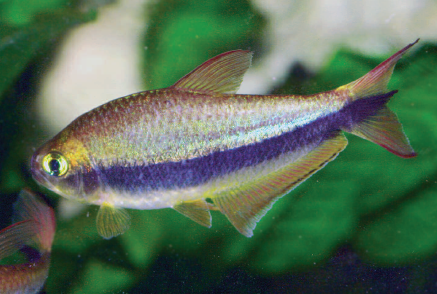
Courting male N. palmeri.
In the aquarium
The maintenance of Nematobrycon species is easy, and feasible even for beginners. These fishes like richly-decorated aquaria with lots of plants. The substrate should be dark, as then the colors of the fishes will be seen at their most brilliant. Emperor tetras are somewhat territorial among them – selves. They may like to swim in a loose group some of the time, but males also defend small spawning territories. Hence these fishes are best kept in a group of 10 or more individuals in aquaria with a length of 50 to 60 cm upwards. Quite small tanks with a volume of a few liters are adequate for breeding. If the fishes are left to spawn regularly then they can be bred very effectively, easily producing more than 150 young per pair per spawning. If these fishes don’t spawn regularly then many of the eggs are non-viable. Emperor tetras are peaceful towards other species. Hardness and pH are unimportant except for breeding. All the usual foods for ornamental fishes are eagerly accepted. All in all, emperor tetras are not only attractive but also very interesting fishes. Sure, the novice will initially buy them largely for their striking appearance, but even the advanced aquarist can undertake numerous interesting studies of them.
Anzeige






